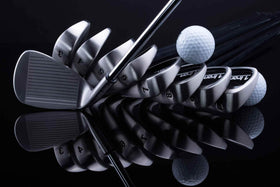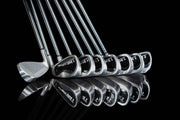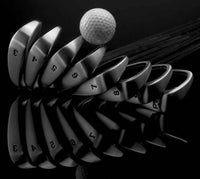Solid Golf Ball Striking with Single Length Irons
by David Lake
The thrust of the articles on the Golf Tips page of our website is that, although you already have the single swing ingrained to use with all of your 1 Iron single length irons, the mental challenge of using just this one swing, set-up, and ball position with all of your clubs is something that takes time to get used to. You consciously know to use this one swing with all of the irons but you will unconsciously use your old ingrained “long iron” swing when hitting your 1 Iron single length #3, #4, and perhaps #5 iron. It just takes some time, practice at the range, and swing repetition to overcome these ingrained habits.
As an example: I built a set of 1 Irons for a very close friend of mine a few years ago and about a month afterwards I asked him how he was hitting them. He told me that he hit the #5 iron through wedges great but was having problems with the #3 and #4 irons. The first thing I did was to explain to him that every iron in his bag was identical with the only exception being the loft angle of the clubface. Therefore, it just made common sense that if he could hit his pitching wedge well he should be able to hit his #3 iron just as well. Then we went to the range and I handed him different irons and had him hit five shots with each one. The thing was that I handed him his #6 iron telling him that it was his #8 iron (five perfect shots), his #5 iron telling him that it was his #7 iron (five perfect shots), and finally his #3 iron telling him that it was his #5 iron (again, five perfect shots). After hitting his #3 iron I asked him how the shots felt and he said that they felt great but that he had never hit a #5 iron that far in his life. I told him that he still hadn’t and to look at the bottom of the club to see what iron he was holding. After he picked his jaw up off the ground I again explained that getting used to a set of single-length irons is 90% mental after playing standard length golf clubs for years. Anyway, he never had a problem after that because my trick convinced him of the reality of what I was saying. Sometimes it is necessary to shock your conscious and subconscious mind by a thorough convincing in order to eliminate ingrained habits.
One of the ingrained swing habits that most golfers have without even knowing it is that they sway forward of the ball through impact. You have heard me preach time and time again how moving forward or swaying through impact will destroy any chance of solid ball striking. The reasons are simple: 1): you effectively de- loft the clubface ensuring a low ball flight (maybe 5 to 10 feet off the ground with a #3 iron); and 2): it is impossible to achieve a full wrist release through impact if you are ahead of the ball (this causes a weak shot to the right). A big part of the problem is that through years of playing standard length clubs you are used to playing the ball back in your stance with the short irons, the middle of your stance with the mid- irons, and forward in your stance with the long irons. The interesting part is that very few golfers move forward of the ball through impact using their short and mid-irons. The reason for this is that using a rearward or center of stance ball position tends to freeze you into a center of stance body position through impact. This is the reason that golfers who switch to single-length clubs never have a problem with their #6 iron on down. On the other hand, using a forward ball position encourages or even forces a forward sway through impact since you are effectively reaching for the ball. After years of playing standard length clubs this swaying to the left when you have a #3, #4, or #5 iron in your hand is so ingrained that it will definitely show up in your swing after switching to single length golf clubs.
There is an old adage that baseball coaches preach to their hitters – “stay behind the ball”. It might surprise most people that his adage did not originate in baseball but rather in golf. Prior to the 1930’s when all sets of golf clubs were single-length sets (for a full discussion of this read the ” Truth about Club Length ” Swing Tips article), the only ball position used was center of stance. Using this ball position the center of the ball would be directly aligned with your nose at address until you gripped your club. Since your right hand is lower on the club than your left it causes your right shoulder to drop which tilts your head behind the golf ball. Consequently, you are automatically behind the ball before you start your backswing. From this point on through your entire swing and follow through the relative position of your head should not change or move forward (again, in the old days the common golf instruction was to keep your head still). This ensures that you are staying behind the ball through impact and making solid ball contact. The advent of varying length clubs within a set during 1930’s changed all this and dictated a forward ball position with the longer irons which required swaying into the ball through impact in order to “catch up” to this forward ball position. Needless to say, nobody has been able to hit a conventional #3 or #4 iron with any consistency ever since.
All of this also holds true for the fairway woods as well. If you move forward or sway into the shot you will never achieve consistent solid ball contact. Again, the reasons are simple: 1): you will achieve a full wrist release through impact (a “crack the whip” effect); 2): your swing force is directed straight down the target line instead of upwards which a forward ball position promotes.
A final check point is that 1 Iron single length golf clubs are designed for a high trajectory. Our #3 iron produces a trajectory that you would normally associate with a #5 iron but the ball carries forever (distance is a function of trajectory), and if this is not the kind of trajectory you are seeing then I guarantee that you are moving ahead of the ball through impact.










